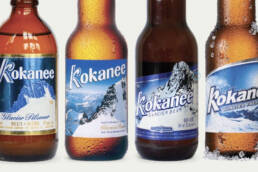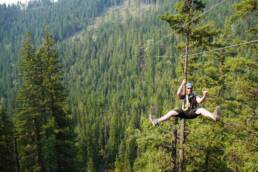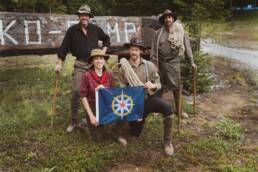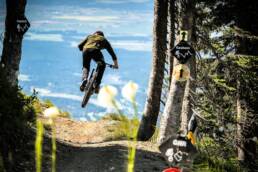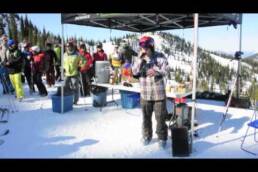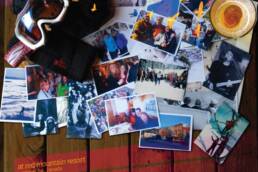The Columbia Brewing Company in Creston, British Columbia, started bottling Kokanee beer in the 1950s. Since then, it has undergone several facelifts. We peel back the label on the weird world of this famous pilsner’s branding. By Chris Rowat.
“Who wants a Kokanee?” isn’t something you hear much anymore. Once an iconic national beer with award-winning television ad campaigns and the title sponsorship of the famous Crankworx Whistler mountain-bike event, this easy-drinking pilsner-style lager is now being crowded out of your local liquor store by craft beers.
Kokanee was first brewed in 1959 by the Creston-based Columbia Brewing Company, which was an amalgamation of four smaller British Columbia craft-type breweries that had been around since the turn of the century in Fernie, Nelson, Trail, and Cranbrook. In 1974, Labatt Breweries purchased Columbia Brewing, and Kokanee beer grew dramatically in popularity with the weight of one of Canada’s biggest beer companies behind it. By 1986, it had cornered a whopping 30 per cent of the market, but six years later it had dropped to 17 per cent, so Labatt decided to rebrand it. This was still the golden era of the big breweries—Molson and Labatt—but Sleeman had entered the market in 1988, billing itself as a craft brewery and taking away market share.
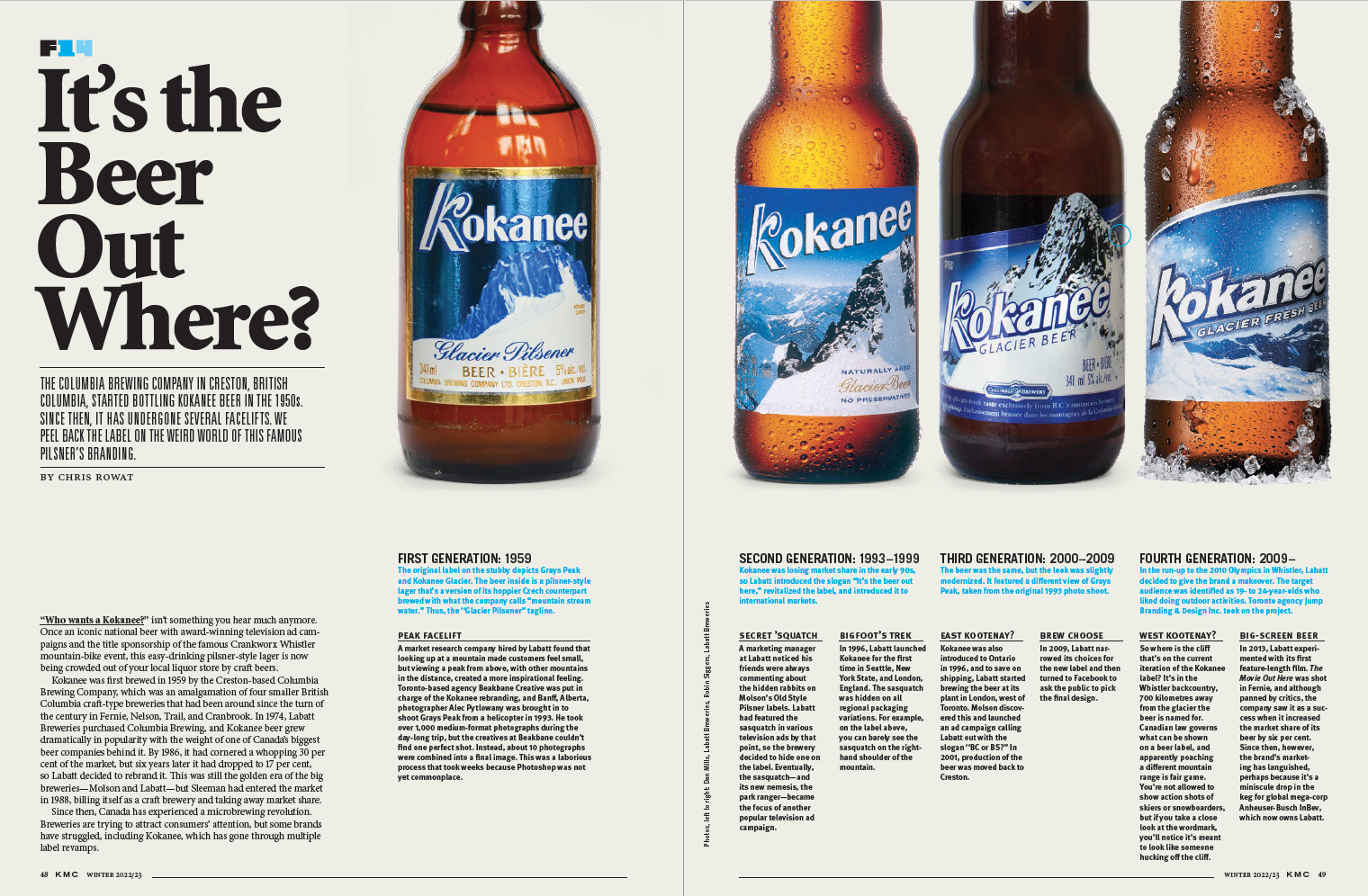
Since then, Canada has experienced a microbrewing revolution. Breweries are trying to attract consumers’ attention, but some brands have struggled, including Kokanee, which has gone through multiple label revamps. Below are the various iterations of the Kokanee beer label.
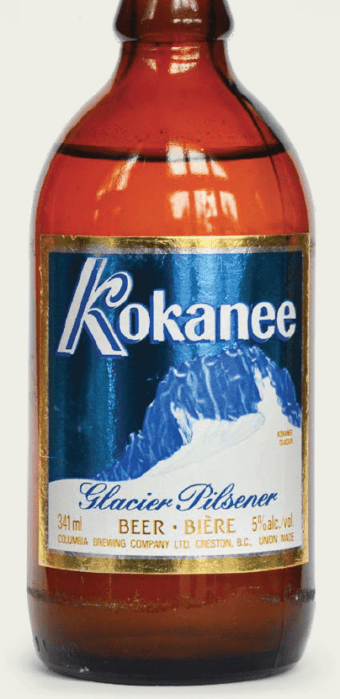
FIRST GENERATION OF KOKANEE BEER LABEL: 1959
The original label on the stubby depicts Grays Peak and Kokanee Glacier. The beer inside is a pilsner-style lager that’s a version of its hoppier Czech counterpart brewed with what the company calls “mountain stream water.” Thus, the “Glacier Pilsener” tagline.
PEAK FACELIFT A market research company hired by Labatt found that looking up at a mountain made customers feel small, but viewing a peak from above, with other mountains in the distance, created a more inspirational feeling. Toronto-based agency Beakbane Creative was put in charge of the Kokanee rebranding, and Banff, Alberta, photographer Alec Pytlowany was brought in to shoot Grays Peak from a helicopter in 1993. He took over 1,000 medium-format photographs during the day-long trip, but the creatives at Beakbane couldn’t find one perfect shot. Instead, about 10 photographs were combined into a final image. This was a laborious process that took weeks because Photoshop was not yet commonplace.
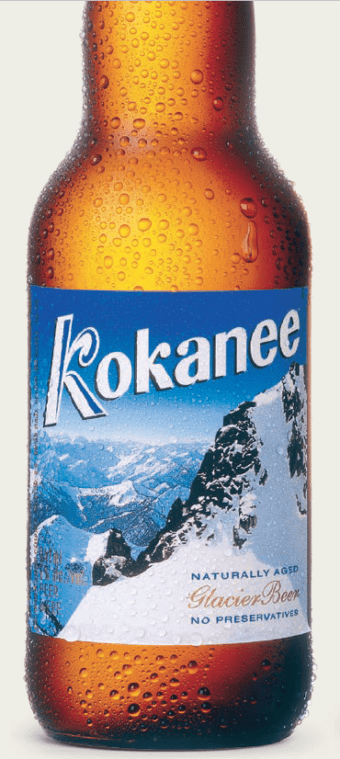
SECOND GENERATION: 1993 –1999
Kokanee was losing market share in the early 90s, so Labatt introduced the slogan “It’s the beer out here,” revitalized the label, and introduced it to international markets.
SECRET ‘SQUATCH A marketing manager at Labatt noticed his friends were always commenting about the hidden rabbits on Molson’s Old Style Pilsner labels. Labatt had featured the sasquatch in various television ads by that point, so the brewery decided to hide one on the label. Eventually, the sasquatch—and its new nemesis, the park ranger—became the focus of another popular television ad campaign.
BIGFOOT’S TREK In 1996, Labatt launched Kokanee for the first time in Seattle, New York State, and London, England. The sasquatch was hidden on all regional packaging variations. For example, on the label above, you can barely see the sasquatch on the right-hand shoulder of the mountain.
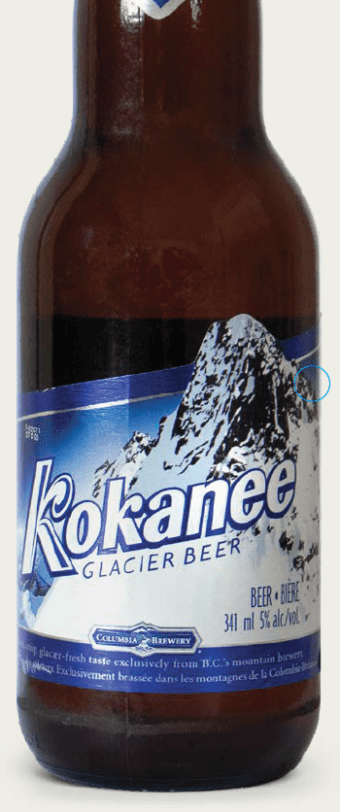
THIRD GENERATION: 2000 –2009
The beer was the same, but the look was slightly modernized. It featured a different view of Grays Peak, taken from the original 1993 photo shoot.
EAST KOOTENAY? Kokanee was also introduced to Ontario in 1996, and to save on shipping, Labatt started brewing the beer at its plant in London, west of Toronto. Molson discovered this and launched an ad campaign calling Labatt out with the slogan “BC or BS?” In 2001, production of the beer was moved back to Creston.
BREW CHOOSE In 2009, Labatt narrowed its choices for the new label and then turned to Facebook to ask the public to pick the final design.
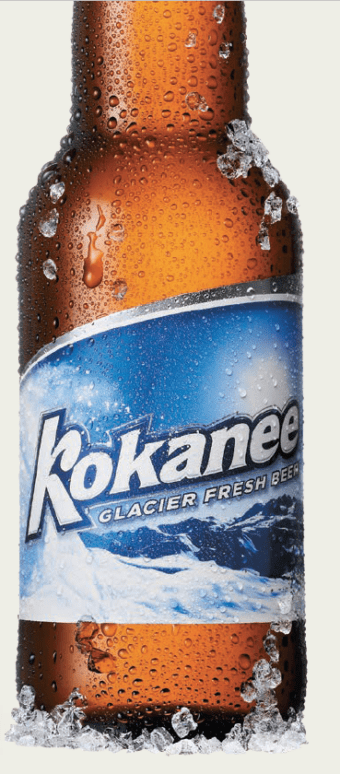
FOURTH GENERATION: 2009 –
In the run-up to the 2010 Olympics in Whistler, Labatt decided to give the brand a makeover. The target audience was identified as 19- to 24-year-olds who liked doing outdoor activities. Toronto agency Jump Branding & Design Inc. took on the project.
WEST KOOTENAY? So where is the cliff that’s on the current iteration of the Kokanee label? It’s in the Whistler backcountry, 700 kilometres away from the glacier the beer is named for. Canadian law governs what can be shown on a beer label, and apparently poaching a different mountain range is fair game. You’re not allowed to show action shots of skiers or snowboarders, but if you take a close look at the wordmark, you’ll notice it’s meant to look like someone hucking off the cliff.
BIG-SCREEN BEER In 2013, Labatt experimented with its first feature-length film. The Movie Out Here was shot in Fernie, and although panned by critics, the company saw it as a success when it increased the market share of its beer by six per cent. Since then, however, the brand’s marketing has languished, perhaps because it’s a miniscule drop in the keg for global mega-corp Anheuser-Busch InBev, which now owns Labatt.
Chris Rowat
Related Stories
Getting High on the Kokanee Mountain Zipline
Our writer savours the Kokanee Mountain Zipline, Nelson’s newest forest-soaring tourist attraction. As a rock climber I…
Why The Mystery Mountain Expedition Was Renamed Misery
Last summer, members of the Canadian-Eh Society set out to re-enact the 1926 expedition to Mt. Waddington, aka Mystery…
This Is Why Mountain Bikers Are Stoked On Whitefish, Montana
There are many reasons why Whitefish, Montana is suddenly on every mountain biker's radar and a 3,800-foot descent is…
Why You Tour Contest
This has nothing to do with our magazine, other than the fact that we're big fans of CMH (Hans Gmoser is a Kootenay…
Insane Mountain Beat Boxin’
We don't know who this guy is, or where he came from. He showed up at the Kootenay Coldsmoke PowderKeg Slopestyle last…
The Gathering at Red Mountain
This upcoming Easter weekend RED and POWDER Magazine are presenting the 2nd annual Gathering at RED. Come hang with…


